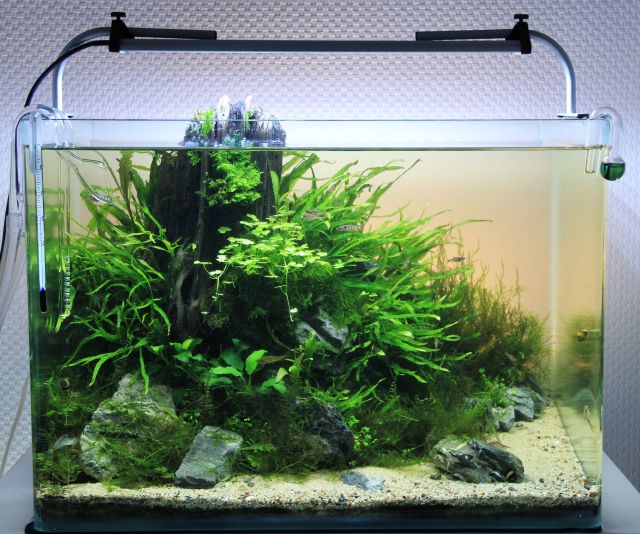An aquarium is a self-contained ecosystem for fish, invertebrates and aquatic plants. Here, many different biological processes take place, which intertwine and - in their entirety - represent an ecological cycle. For example, certain waste products of animal inhabitants are first processed and degraded by bacteria and eventually processed by the aquarium plants (nitrogen cycle). A diverse and balanced bacterial balance plays a big role, just like larger salvors such as useful shrimp and snails. For a healthy and easy-care aquarium, these recyclers (destructors) are particularly important, even if they are often much more inconspicuous than the colorful fish. Nevertheless, some outside help is needed to keep the ecological balance stable, especially in the long term. Here the aquarium owner must become active and exercise regular care measures. In this article we will present them in more detail according to type and scope.
Water change
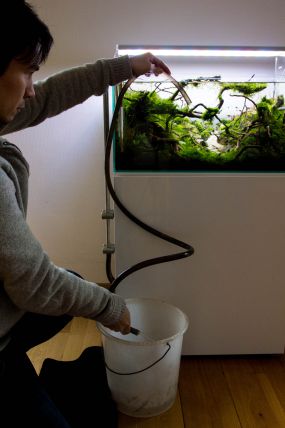
A water change does not only serve the purpose of adding fresh water - which most fish are super happy about, by the way, making them more agile. Sometimes even spawning or mating behavior can be triggered. In addition to the introduction of fresh, unloaded water by a water change, contaminated water is removed and the concentration of undesirable substances in the aquarium water is reduced. We recommend a regular, weekly water change with a replacement of half (50%) of the water. For more information and even more tips and tricks on this topic, please check out the article "Water change".
However, the operation of a backwater aquarium is quite possible. Here no water is changed, but only evaporated water topped up with osmosis water. In order to reduce pathogenic stress - the bacterial load - of the water, sterilizers like the Twinstar or UV-C filters can be used. Missing nutrients need to be supplemented by targeted fertilization.
Cleaning measures
Many beginners have a totally wrong picture in their head, causing them to perform a cleaning job like the following: The aquarium, including the substrate and filter is regularly (monthly) cleaned thoroughly and liberated from all dirt (sludge). The substrate is de-sludged with an extractor and all filter materials are either replaced or cleaned in hot water.
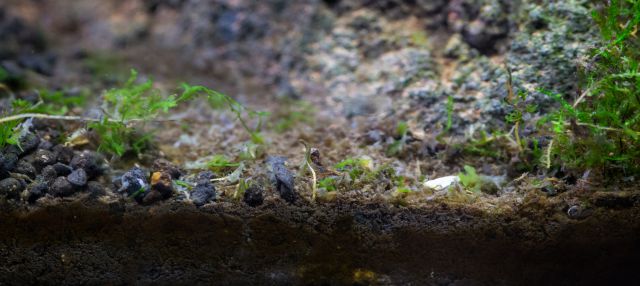
Withal, sludge plays an important role in the aquarium’s ecosystem, since it is home to a huge amount of pollutant-degrading bacteria, just like the filter sludge. If you now remove all "dirt" from the soil and filter, a large amount of beneficial bacteria is lost. Such a cleaning measure is therefore equivalent to restarting an aquarium, which then basically has to re-enter the cycling phase. Peaks in poisonous ammonium and nitrite can be the result, and end in the death of your aquarium’s inhabitants.
Therefore, when cleaning the filter and substrate, you shouldn’t be too rigorous and leave a part of the sludge inside the aquarium. Ideally, these measures need only be carried out very rarely, for example if too much visible sludge has formed on the ground (which on the other hand can be easily extracted with a hose) or if the flow rate of the filter is jeopardized by too much filter sludge. If this is the case, you should gently squeeze the prefilter materials (cotton or sponge pads) under lukewarm, flowing water and then reuse it. This keeps intact part of the bacterial culture. A complete renewal of the material is not necessary. Usually these jobs are a rare thing, say every few months.
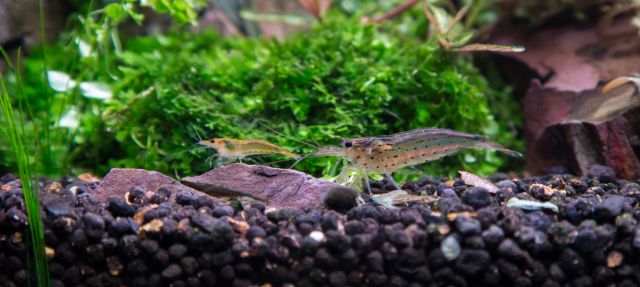
Incidentally, sludge-and-leftover-eaters such as snails and shrimp can make care work much easier. They process larger waste such as leftovers, carrion and dead plant parts into smaller pieces, which can be subsequently better processed by bacteria. All surfaces, on which dirt usually accumulates, look much cleaner thanks to the cleaning team.
Cleaning the panes
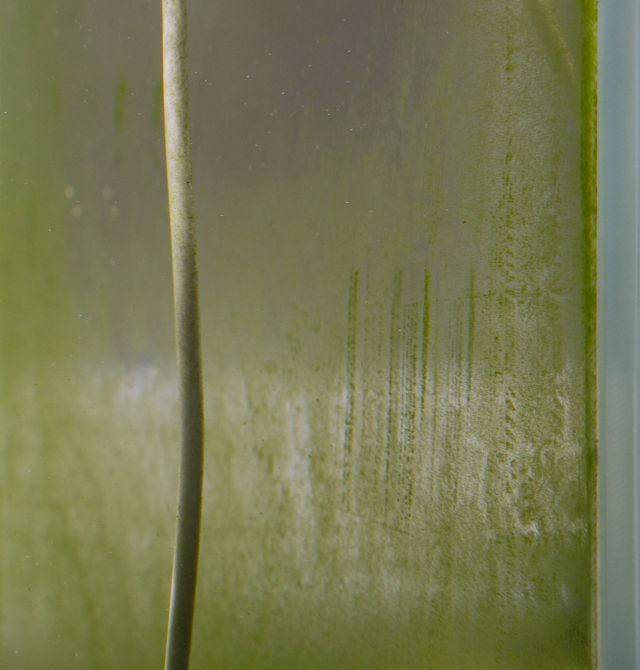
Nothing’s quite as off-putting as looking at dirty aquarium panes, tarnishing the view. In this respect, the regular cleaning of the aquarium panes, both inside and outside, is a sensible care measure. Many find this maintenance work very cumbersome. That is why it is a tremendous relief to be able to rely on well-suited tools that simplify pane cleaning.
Above all, depending on illuminance, planting and nutrient balance in the aquarium water, visible deposits form on the inner panes, which usually consist of different types of algae. These might be brown diatoms, soft, green algae coats or harder spot algae. It is very beneficial here, too, to confront the algae with enough algivores as a countermeasure. Clithons or Neritina for example, are ideal annihilators of algic coats, not just on the panes but also on leaves and aquarium decoration. But also invertebrates like the algivorous Amano shrimp or other various dwarf shrimp species tirelessly graze the coats. If there are enough algivores in the tank, it definitely reduces the aquarist’s cleaning efforts quite significantly. Ideally, the inner panes will only have to be cleaned very seldomly or never. In the case of recurring algae infestation, regular cleaning is recommended, such as once a week. Ideally, this work is combined with the already necessary water change.

Various tools are available for cleaning the panes. Scrapers, with or without extender, are the right tools for all kinds of coatings. Even hard spot algae or even limescale can be scraped off with a sharp blade. The Magic Cleaner Sponge or the Seachem Algae Pads are ideal for biofilms with fluffier diatoms or softer green algae coverings.
Even the outside of the aquarium should be cleaned from time to time from stains and fingerprints. This can be done with a regular grocery glass cleaner. Further information can be found in the article "Cleaning an aquarium tank" right at the bottom of the article, in the final paragraph on "Cleaning the glass in a running tank".
Gardening
Especially, when many fast-growing aquatic plants (e.g. stem plants) are used, that find ideal circumstances to grow thanks to lush fertilization and strong lighting, a regular trim makes sense, to not let the fast growers get the upper hand, dominating and overgrowing everything else. Slower plants will get shadowed and may wither. From the aquascaper’s point of view, regular trimming for aesthetic reasons is an important task, so that the aquarium layout stays in good shape.
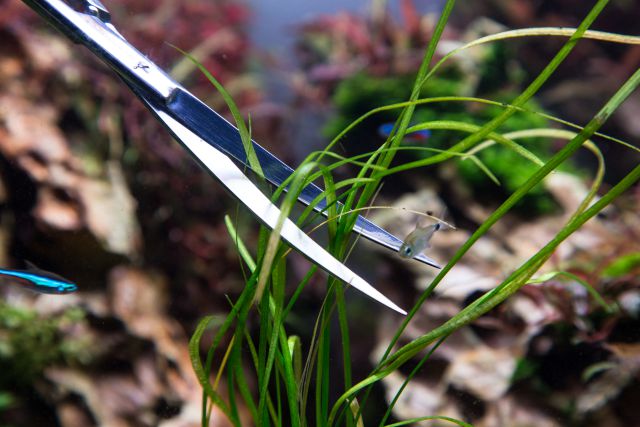
To properly trom aquarium plants, special aquascaping scissors are more suitable than craft/office/household scissors and suchlike. There are particularly suitable scissor models for every possible application, e.g. spring scissors or wave cutters are ideal for the trimming of ground cover. An overview of all the various aquascaping scissors can be found here.
After major trimming, quite some plant residues will accumulate on the water surface of the aquarium. Completely removing them is an annoying but necessary job. The article "Effectively remove plant clippings" presents a practical solution, simplifying the tedious scooping of the last plant snippets out of the water.
Food
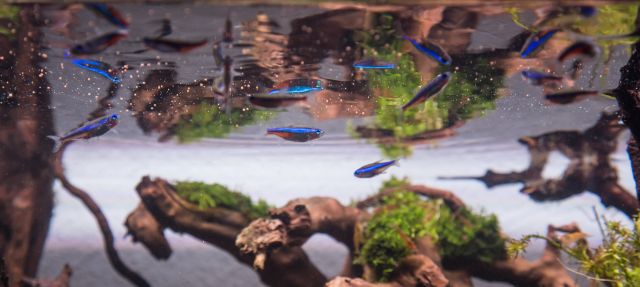
Of course, the inhabitants of an aquarium such as ornamental fish, snails and shrimp also need food. The feeding of the animals does not take much time and feeding time is always an optical highlight: watching the animals eat. A species-appropriate and modest feeding is vital. In our Aquascaping Wiki, you’ll find a proper article on that topic. It is better not to overfeed the animals and thus not burden the ecosystem in the aquarium too much. Some fasting days a week are actually healthy. Especially for growth eaters, there is always some food available, e.g. biofilms and micro-organisms. Thus, fish, shrimp and Co. survive even longer absences of the owner without problems.
Fertilizing aquatic plants
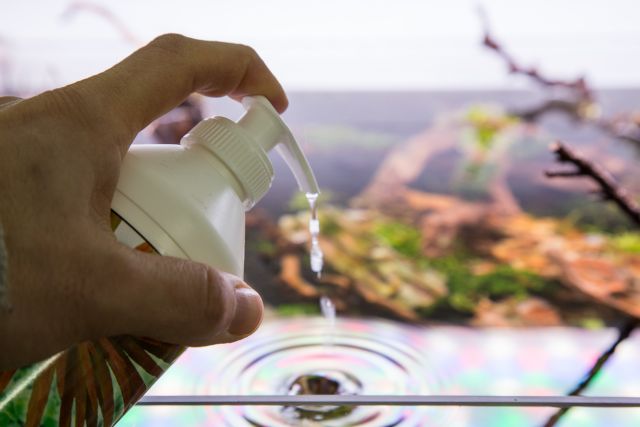
Especially aquascapes or other planted aquariums profit from fertilizing the aquatic plants. Aquarium plants need a broad array of nutrients, among those e.G. light, carbon via CO2 addition, micro- and macronutrients. Sounds like more work, than it actually is. Lighting and the CO2 system with night shut-off can be controlled automatically using a timer. Here, the aquarium owner does not need to do any elaborate work, except checking the technology from time to time, adjust here and there if need be and refill empty CO2 bottles. If you use a suitably large container (such as a 2 kg bottle), this is a maintenance measure that occurs only every few months.
Fertilizing the plants with liquid fertilizer can be a little more work. Depending on the requirements of the aquarium plants and the technical equipment of the aquarium, a weekly fertilization is sufficient. In a high-lumen system with many and strong-consuming plants, daily fertilizing is recommended. Although this process only takes a few minutes, regular administration is very important. Fertilizing can be made easier with automated dispension using programmable dosing pumps.
How much time for aquarium maintenance?
Daily fertilization, the the checking glance into the tank and taking care of the fish may take some overcoming at first, the actual effort takes only a few minutes a day. You can estimate about 5 minutes for this.
You should take a little more time for the weekly water change. The best way to proceed here, is to combine this with cleaning the panes, trimming the plants and siphoning the sludge if necessary. Dirt, plant remains and suspended matter can be excellently removed while siphoning the old water out of the aquarium tank. Once the filter has stopped, you can also do some maintenance parallel to the water change.
Depending on the size of the aquarium tank and the aquarist's demand for cleanliness and aesthetics, this more complex work may take up several hours. For a simple standard aquarium with some aquatic plants, however, usually about 30 minutes are sufficient. Again, it often takes longer to overcome your inner sloth, than the actual effort itself.
Working in and around the aquarium may seem tedious but has definite, meditational qualities. And last but not least, as an aquarium owner, you will be rewarded in the end: with a clean and attractive aquarium, which you can fully enjoy again after your work is done.
